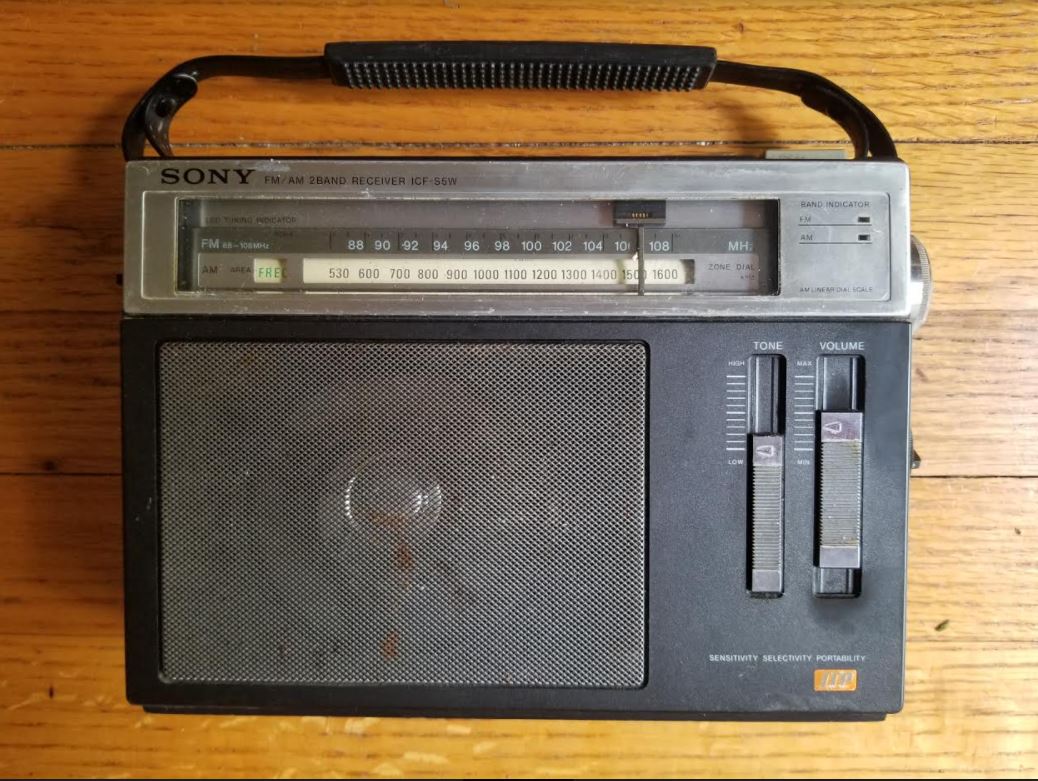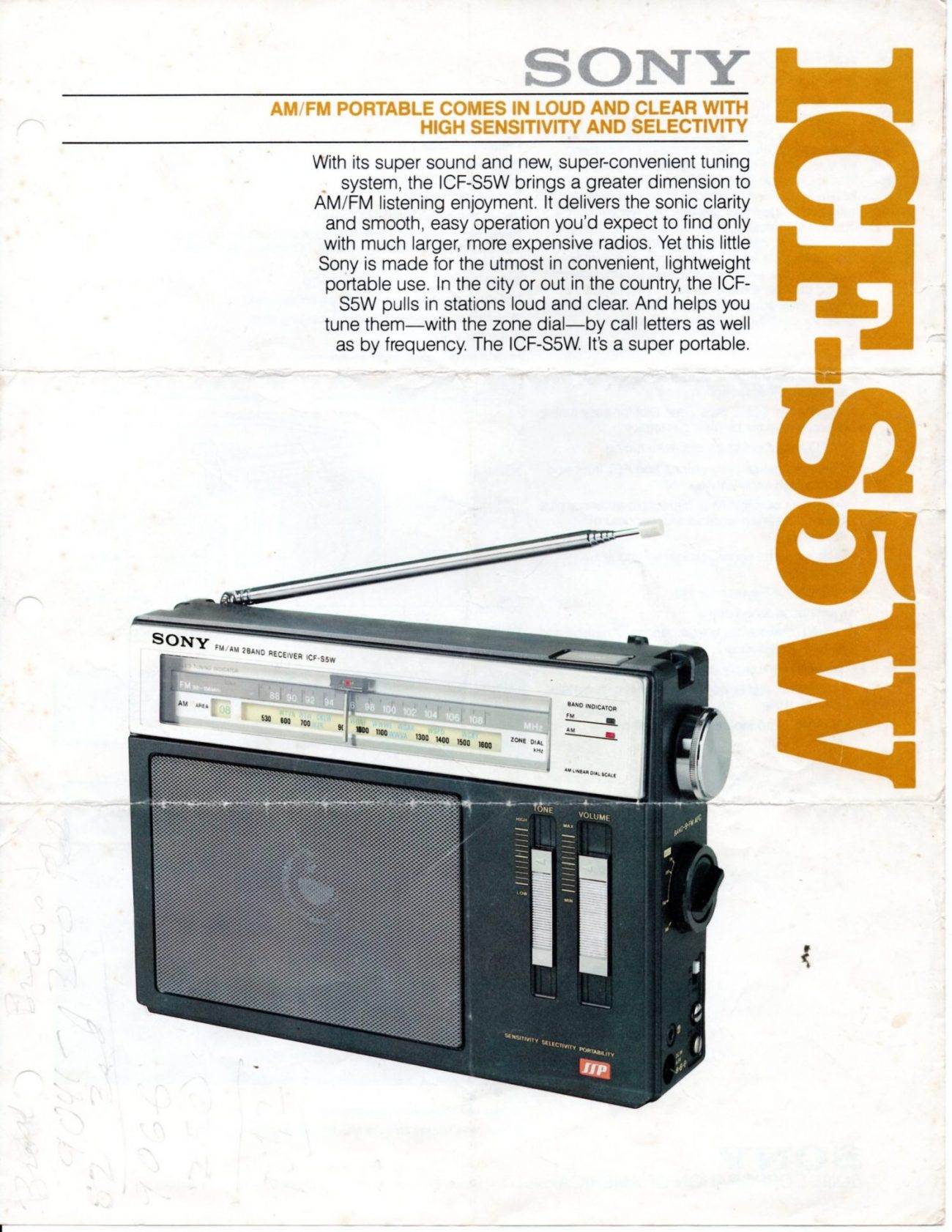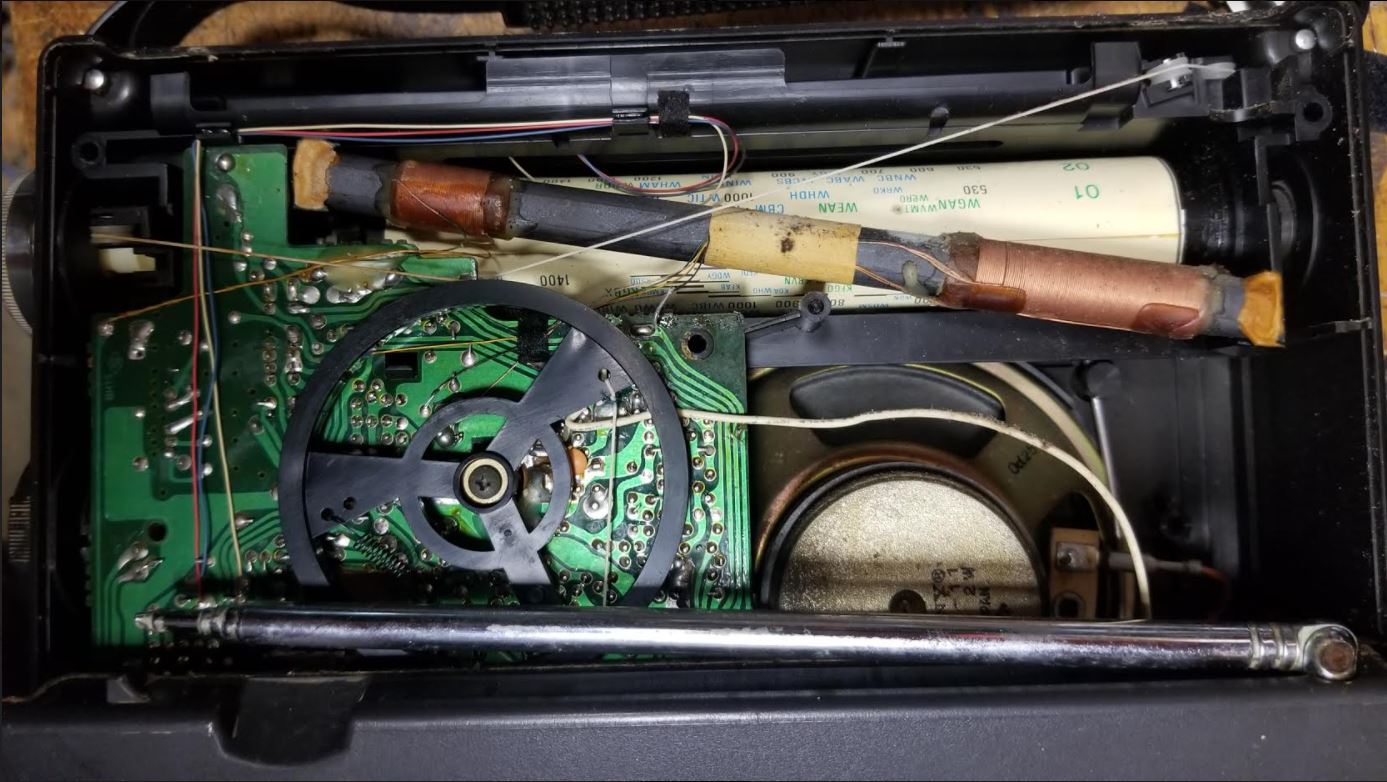 In reply to our Caveat Emptor post, many thanks to SWLing Post contributor, Zack (N8FNR), who writes:
In reply to our Caveat Emptor post, many thanks to SWLing Post contributor, Zack (N8FNR), who writes:
Attached is a copy of the Sony brochure for the ICF-S5W, a photo of the front and also the inside. This is a fairly old rare radio and some of your readers might enjoy the following.
I just wrote to Dr. Vlado asking if he can restore my fairly rare Sony ICF-S5W. Luckily I have three of them, two of which are dead so I could send all three and he could possibly cannibalize them to make one good working rig. I also have an original copy of the manual.
Few people have heard of the ICF-S5W as it was only made from 1980-81. One of the interesting features of the radio is that the Sony engineers put the 16cm ferrite antenna at an angle as they claimed it improved incoming signals.
Many reviewers at the time claimed that it was better than the GE Superradio of that vintage.
If you would like to know more about this radio below are a few reviews.
Thank you for sharing this, Zack. I was not familiar with the Sony ICF-S5W. I love the simplicity of this radio–and that nearly diagonal ferrite bar? I can’t think of any other radio I’ve seen with that!
And having spare “parts” radios is a solid plan if you have a particular radio you love and want to keep it in working order over the long term.
Any other ICF-S5W owners out there? Please comment!




My ICF-S5W’s LED tuning indicator only displays the central red light when the radio is set to receive FM. This red LED remains illuminated regardless of whether AFC is on and FM reception isn’t affected. The two green and one red LEDs still work fine on AM, which continues to be a DXing delight.
Any idea what’s causing the LED issue on FM? I’m disinclined to open the radio and have a look since I never bought it for FM, anyway.
I have the S5W, in fact it’s the radio I have owned the longest, I bought it when it was new at the Grand Opening of the first The Wiz store in NYC, it was on special for $29.95 which if I recall was about $20 less than the list price. I don’t think the 1981 one year date is correct. I bought mine in late 1978 or early 1979 when the Wiz opened, and it was available for at least a couple of years.
Yes, it’s a great radio, with a couple of drawbacks. The audio is not all that great, and it’s not really very good on FM (not that I bought it for FM). The radio is still working, the only problem is that the sliding tone control not longer works. Also, although supposedly a selling point, the metal speaker grill was not a good idea. It’s somewhat rusty, just from being outdoors from time to time, it’s never been rained on.
One other point. It did have a competitor,, but not the Panasonic that has been mentioned. It was the Panasonic 1090. The Panasonic was a much nicer looking radio, had better sound, and a dial light. But it was a much worse DXer. I had that one too. Much better for every day listening, but not for Dxing. That one went dead on me in the early 2000’s.
Thanks for reminding me that I have this radio. I think I’ll bring it up from the basement for a little DX listening tonight.
One thing that I forgot to mention is that the radio uses a Murata 455 kHz filter.
I have experienced better AM reception on original GE SR, GE SR-II, original CCrane EP and 2011 made Sangean PR-D5 by tilting the radio to about the angle of that unusual Sony ferrite rod mounting, and even started using a beefy Manhassett brand name sheet music stand to hold radios at that angle. This is especially true when my neighbor has his Panasonic Plasma TV on and the end null of the ferrite needs to be “exactly so.”. I have often thought that it would be great if more radios had 1/4 thread camera mounts recessed on the bottom so that tripods could be more easily used.
I have previously read posts by Bruce Carter in Texas about adding 6 khz ceramic filters salvaged from wireless mice to older radios. Has anyone had success adding filters to GE Superadios or Panasonic 1401D’s? At one time Kiwa Electronics offered a “no loss” ceramic filter add in unit that contained an IF amplifier to negate the dBs of filter loss and required a tap for a 4 to 12 volt power supply.
There used to be an article about narrower ceramic fikters for FM in the Superradio. And other articles about tge tooic in general for FM receivers.
I’ve never seen anything suggesting mice had suitable filters (filters aren’t the same as crystals or resonators that would be in mice). It seems unlikely that they’d just happen to have resonators at 455KHz for AM, or 10.7MHz for FM.
The Superradio doesn’t use ceramic filyet for the AM IF.
One scheme is to use ceramic resonators or crystals to replace bypass capacitors in the emitter of the IF stages. So there’s a peak on the resonator’s frequency.
In playing around with some radios after see the unusual tilt of the Sony ICF S5W,I now have a new suspicion for why their engineers thought it was an improvement – the deepest “end null”” in signal strength is not directly in line with the ferrite rod, but instead the deepest signal strength null is at just about the tilt angle the Sony ferrite is mounted at.
Sony engineers were giving their “enthusiast” customers a way to reduce co-channel interference.
Does this also explain why the ferrite rod length is not the “Gold Standard” of 200 mm/ 8 inches?
Is 160 mm length the optimum for deepest null?
I have wondered why Sangean put the oddly shaped ferrite block antenna in my 2019 PR-D4W when my 2011 and 2021 PR-D5s and 2015/2020 PR-D15s had the traditional round 200 mm ferrite antennas. In designing the PR-D4W did Sangean discover something about ferrite dimensions? There is enough room inside the PR-D4W for a longer ferrite, especially if it were tilted like the ICF-S5W.
The 2011 and 2021 PR-D5s are different radios inside, despite both having 200 mm sticks.
The year 2011 purchased PR-D5 is noticeably more sensitive and its volume control can raise a weak signal far higher than the year 2021 bought PR-D5, yet the 2021 model seems to have a sharper end null. I suspect the 2021 PR-D5 has the “guts” of the current PR-D15 but with some features disabled.
Matt’s post awhile ago on the FIM-41 has me suspicious that air core loop antennas are superior to ferrite loopsticks for the weakest signals.
I, as a lover of this Sony brand, found this radio very interesting.
I hope it is all recovered and will be working very well.
Congratulations for the copy.
Oliveira
QSL do Brasil